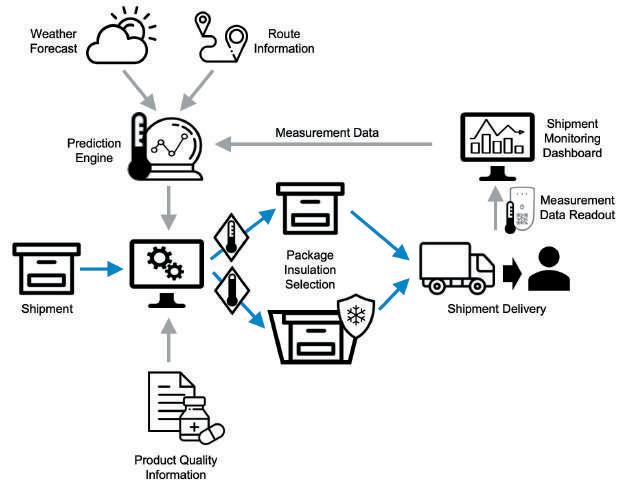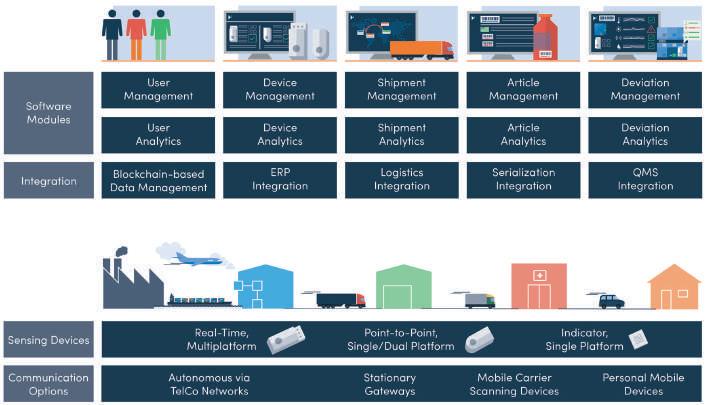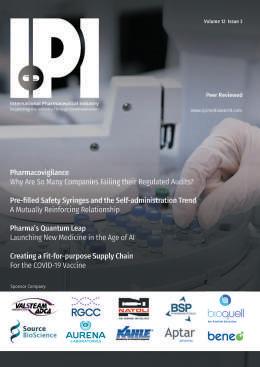
15 minute read
End-to-end Visibility – The Foundation of Addressing Today’s Challenges in Pharmaceutical Distribution
from IPI Autumn 2020
by Senglobal
Over the last few years, challenges in the distribution of pharmaceuticals have grown with the need to have better visibility along the entire chain in order to act fast due to disruptions or prevent them from happening at all. Thankfully, technology in recent years has provided more than just visions of how to address these challenges. It provides solutions to connect and synchronise the flow of physical goods with the flow of information, therefore reducing the manual effort to handle information. Creating insights out of data and sharing these insights across the supply chain have gone beyond the pure proof-of-concept phase. Companies should start to digitalise this process in a targeted manner, looking for solutions that are adaptable and future-proof.
The principle of providing the patient with the best treatment at the right time, with high quality and low cost, has remained unchanged in the pharmaceutical industry. Achieving this objective however has not become easier over the years. In particular for the distribution of finished goods, ensuring quality while reducing effort in today’s global supply chains with large product portfolios has become more and more difficult over time.
Challenges Supply Chains Face Today – Increasing Complexity, Regulatory Scrutiny and Customer-centricity A general increase in supply chain complexity and risk is one of three key challenges in goods distribution, driven mainly by continuously expanding global supply chains. This entails companies working with several logistic service providers (LSPs) for different product types or distribution channels (e.g. direct markets vs. wholesale), where the LSPs use their own, often unknown, subcontractors. Shipments to remote regions or to regions with economic and social instability are harder and more costly to manage. Highvalue treatments with short shelf-lives further add to complexity in managing the distribution effectively.
Secondly, in the last few years we have seen a rise in regulatory scrutiny in the pharmaceutical industry. Just in the area of finished goods distribution alone, there were key regulatory pieces which came into force either fully or in a phased approach: The EU Falsified Medicines Directive (FMD), which requires prescription medicine to be tracked and monitored on a sales unit level, the updated EU Good Distribution Practice (GDP), which included more stringency regarding condition monitoring of goods, and the US Drugs Supply Chain Security Act (DSCSA), which also requires unit-level traceability to be implemented by 2023 and sets out new rules with regard to resaleable returns. Such regulatory requirements are an additional burden on the organisation and come with an increase in costs and process complexity.
Thirdly, customer-centricity has also arrived in the pharma industry. On the one hand this is driven by the patients themselves with higher expectations regarding transparency, information accessibility and interaction options – one example is how patients today can self-diagnose using online resources to the extent that they already have certain treatment suggestions they would like to discuss with their doctor1. On the other hand, there is an increasing trend towards tailored treatments based on gene therapy or personalised drugs driven by the smaller pharmaceutical or bio-tech companies themselves to increase the ratio of efficacy to cost, as producing “blockbuster” drugs are becoming more and more expensive2 . The bottom line is that pharma needs to move closer to the patient and see them more as customers, with success driven by a greater focus on the customer experience, rather than on the actual product and related specifications3. However, in order to be a part of the customer journey, pharma companies need to know more about their customers, which means relying on advancements in technology to collect information in an efficient and unobtrusive manner.
On top of all of this, the last few months have shown that global supply chains have been put to the test by COVID-19. The pandemic has exposed weaknesses, which manifested through delays or shortages of goods. Companies will not only need to look into fixing weak links in supply chain processes and revalidate them but rethink their global supply chain strategy to avoid the impact of such catastrophic events as best possible. A broader portfolio of sourcing and distribution options will need to be taken into account, increasing redundancy to some extent but at the same time increasing flexibility to adapt to imminent supply chain disruptions.
End-to-end Visibility is the Door to the Digital Kingdom and Technology is the Key To address these challenges, the importance of end-to-end visibility and the ability to continuously collect data points with regard to the whereabouts and conditions of the goods shipped cannot be stressed enough. This is the basis for improving control as well as implementing automation to
reduce manual effort, for example through parametric quality releases. In order to achieve this, we see three key steps which need to be implemented: 1. Establishing a clear link between the physical world and flow of goods with the digital world and flow of information, 2. Generating actionable insights from collected data along the entire distribution chain irrespective of custodian and location, and 3. Establishing a secure mechanism for sharing events with multiple supply chain actors.
Advancements in technology over the last five years have made it easier to implement the above-mentioned steps. Today better and more affordable solutions are available on the market for collecting, processing, sharing and presenting. Using smart IoT sensors in combination with cloud computing, it is now possible to connect to the physical world and clearly link the measured data to digital representation of the respective goods (a “digital twin”) with little to no manual effort. In combination with machine learning methods, the collected real-world data can be analysed autonomously to identify patterns and generate insights to support decision-making. And finally, DLT-based networks enable a trusted and secure way of not only representing the flow of goods in the digital world and sharing related events with supply chain partners, but also as a platform for implementing data-driven process automation based on agreed business rules while ensuring data integrity without a centralised governing structure.
A project we completed with a partner around adaptive packaging selection for last-mile pharmaceutical deliveries illustrates the potential of new technologies as mentioned above. Instead of using just one passive cooling solution for all types of temperature conditions, a more flexible offering with a variety of options best suited for the respective conditions on the day of shipment was envisioned. The overarching goal was to reduce manual handling effort and costs by choosing lighter and cheaper packaging solutions if temperature conditions were favorable. Based on the on-average lower costs, a more attractive pricing for the service could be offered to customers and the competitiveness with temperature-controlled alternatives, such as active cooling. A system would suggest the optimal packaging and day to the logistics team from an available selection based on the predicted temperature, a chosen shipment time window within one to two weeks and a variety of parameters driving the predication risk, such as temperature bounds, value of the shipped goods or model accuracy. The underlying model would use a combination of IoT sensor data and machine learning to predict the temperature within the package based on historic sensor data, start and end point of the route (detailed route information was not required) and the external temperature forecast. To understand how many shipments would not require full thermal insulation, but only a reduced level or even none (standard packaging) we sampled 800 shipments in Switzerland during the winter period between January and February. The results showed that for cold chain shipments with a temperature band of 2 to 8 degrees Celsius, around 40% had the potential for optimisation. The model showed an average accuracy level of 91% when validating the predicted temperature with the actual temperature measurement in the package. Particularly promising was that accuracy of the model increased over time through self-learning, with levels reaching 99% to the end of the period. This example of digitalisation nicely illustrates how measuring, optimisation and automation go hand in hand to improve day-to-day logistics processes by leveraging digital data. Key Technology Driving Supply Chain Digitalisation Cloud Computing In a nutshell, cloud computing is the delivery of pay-per-use computing services over the internet (“the cloud”) to move away from on-premise IT hardware and to offer faster innovation, flexible resources, and economies of scale. Cloud computing started picking up between 2005 and 2010, when the likes of Amazon and Google launched their cloud services, allowing the rental of online space to either edit and store documents or to run applications remotely. Today it has become the backbone of most companies that rely on cloud services for anything from storage and applications to infrastructure and backup solutions.
Internet of Things (IoT) The IoT is a system of interrelated computing devices embedded in or attached to a variety of objects. These devices are provided with unique identifiers and the ability to transfer data over a network without requiring human interaction. IoT essentially enables smart and saleable data collection in the physical world. Having emerged around 2013, IoT adoption grew in the last three years, with more companies being able to reap firsthand benefits from applying the technology in their operations4 .

Figure 2: An application example of AI and IoT – dynamic packaging selection: The optimal packaging is suggested by a system using information on the route, the external temperature forecast, historic shipment temperatures along that route and product quality information, such as the allowed temperature bands.
Artificial Intelligence (AI) AI can be described as machine-based intelligence capable of taking actions to achieve specific goals based on the perception of the environment. Machine learning (ML), a subset of AI, is the use of algorithms for classification and prediction, relying on patterns and inference instead. In the business world AI is almost synonymously used for ML. According to a McKinsey study, AI adoption continues, with the largest cost savings seen in the area of supply chain management and manufacturing5 .
Distributed Ledger Technology (DLT) DLT, commonly referred to as block-chain, enables independent computers (“nodes”) to synchronise transactions in the form of a distributed ledger, where each node holds its own copy. Transactions are stored in blocks which are linked via unique references. DLT comes in two flavours: public, where participation in the network is open, or private, which is an invitation-only network run by a group of entities (nodes). The decentralised network design and data immutability combined with the ability to execute tasks based on codified business rules (“smart contracts”) make it an interesting platform for sharing information and implementing process automation between entities. One example in the pharma supply chain is PharmaLedger, an EU Innovative Medicines Initiative, where a DLT governance model is being developed to ensure crossstakeholder collaboration in tracking, verification and authentication of physical goods downstream6 .
Considerations for Implementing End-toend Monitoring Systems Understanding the key challenges supply chains face in the distribution of finished goods, end-to-end visibility is the foundation to address these challenges. With technology being at a point to facilitate with innovative solutions, the question remains how such an end-to-end monitoring and tracking system should look and what steps one should take to get started.
When looking into introducing such a system, we suggest assessing the following management and analytical functionality along the following dimensions:

Figure 3: Conceptual considerations for implementing end-to-end monitoring systems • The system users • The IoT sensor devices • The shipments • The individual articles on sales unit level • The deviations occurring during shipments
A distinction is required between shipment and articles primarily, as condition deviations during shipments can impact the respective articles differently based on their individual product stability data over the course of several shipment stages.
A key point is that the system can assign collected sensor data on an article level, irrespective of what IoT sensing device is being used per stage in the distribution. More expensive real-time data loggers used in the primary distribution from manufacturer to a regional distribution hub (shipment duration typically between three to five days) for example, are too costly and are overkill in the last-mile distribution from wholesaler to pharmacy (shipment duration typically within 24h).
An often forgotten aspect is the ability to handle the large amounts of data being collected. This is not just a question of having sufficient and flexible storage space which is easily accessible, but the effort to process the data to generate insights. Five years ago, advanced analytics might have been more of a nice-to-have, however due to the increase expected through IoT sensing devices, functionality that can reduce manual effort of pre-processing and analysing data has grown in relevance.
Finally, strong interfacing capabilities are a must in order to connect to other relevant supply chain or quality management systems within the company. Such interfaces are ideally already available for the most commonly used applications, or if not, require little customisation. In particular, connections to warehouse management systems help to avoid breaks in condition monitoring between individual distribution segments, as sensor devices used during shipment are removed or exchanged at these points and facilitate an on-the-fly configuration of the sensing devices during the commissioning of a shipment, pulling the respective configuration data from the central cloud-based management platform. One big challenge with regard to sharing data remains a missing industry-wide adopted model for (a) generally sharing data on a DLT network and (b) sharing events related to the condition of goods. With regard to DLT interoperability, one option currently in discussion is to adapt the current GS1 EPCIS standard, which is widely used across industries to share supply chain events and information with other parties7 .
How to Get Started on the Supply Chain Digitalisation Journey Taking first steps in any digitalisation endeavour can be daunting. At Modum, based on our experience, we advise our customers to start following six simple steppingstones: 1. Start small but commit - understand what you want to achieve overall, get your organisation and sponsors mobilised and define clear benefit objectives and pilot key performance indicators 2. Choose the right product – focus on high-value products or products requiring a new type of supply chain (e.g. personalised treatments), and
choose a product where control of the distribution lies predominantly with you (e.g. direct markets) 3. Choose the right lanes – choose distribution lanes where you have a strong relationship with your supply chain partners and where the distribution is completed in maximum three hops 4. Involve your distribution partners – inform them of the benefits and rationale of what you are trying to achieve, understand any potential risks from their end and engage with them as full members of the pilot 5. Onboard a vendor that is also a change partner – choose a sparring partner with a keen understanding of operational processes as well as technology, that can adapt quickly to changes, and introduce the vendor as an integral part of the project team with direct access to relevant parts of your organisation 6. Keep the bigger picture in mind – outline the next phase and its objectives already in the planning phase of the pilot, understand internal organisational hurdles and showcase the pilot concept, planned benefits and interim results continuously to key stakeholders throughout the pilot
The first step is by far the most important one – in our experience projects often start out with great enthusiasm, however interest wanes if key stakeholders and their needs are not taken into account. Therefore, it is crucial to get a commitment from all relevant stakeholders right from the start and “keep the fire alive” as time goes by.
Overall, however, our discussions with different parties along the pharmaceutical supply chain show that the need to increase supply chain visibility is undisputed. The effective use of the real-world data to gain insight into supply chain events and disruptions, identify trends or even predict and consequently facilitate and automate the decision processes, will be a key success factor for companies in the future. The information transparency has the potential to increase trust between supply chain actors, improve efficiency and control, and reduce the operational compliance burden companies are faced with today.

REFERENCES
1. Macphail, T., WebMD Knows Best? How the digital era is changing the way we make medical decisions (2015), https://slate. com/technology/2015/03/webmd-and-selfdiagnosis-how-the-internet-is-changingmedical-decisions.html, visited February 2020 2. Jørgensen, J.T., From Blockbuster Medicine to Personalized Medicine (2007), https://www. medscape.com/viewarticle/573750_5, visited June 2020 3. McKinsey & Company, From product to customer experience: The new way to launch in pharma (2018), https://www.mckinsey.com/ industries/pharmaceuticals-and-medicalproducts/our-insights/from-product-tocustomer-experience-the-new-way-to-launchin-pharma, visited July 2020 4. The Economist, The IoT Business Index 2020: a step change in adoption (2020), https:// eiuperspectives.economist.com/technologyinnovation/iot-business-index-2020-stepchange-adoption, visited June 2020 5. McKinsey & Company, Global AI Survey: AI proves its worth, but few scale impact (2019), https://www.mckinsey.com/~/media/ McKinsey/Featured%20Insights/Artificial%20 Intelligence/Global%20AI%20Survey%20AI%20 proves%20its%20worth%20but%20few%20 scale%20impact/Global-AI-Survey-AI-provesits-worth-but-few-scale-impact.pdf, visited June 2020 6. PharmaLedger, https://pharmaledger.eu/ about-us/activities/, visited July 2020 7. GS1, https://www.gs1.org/standards/ blockchain, visited July 2020
Carl Spörri
As Chief Marketing Officer at Modum, Carl Spörri is responsible for the product portfolio as well as marketing and communications. He holds an MSc in electrical engineering from ETH Zürich and has over ten years of experience consulting clients in various industries in digitalisation and change management. Carl is particularly passionate about applying technology to make daily life easier for businesses and helping them implement innovative business models.
Email: carl.spoerri@modum.io
IBC IFC Page 47 Page 63 Page 17 Page 39 Page 3 Page 13 Page 15 Page 101 Page 29 Page 85 Page 35 Page 93 Page 57 Page 33 Page 99 Page 49 Page 53 BC Page 31 Page 21 Page 83 Page 71 Page 73 Page 37 Page 81 Page 75 Page 41 Page 65 Page 7 Page 86-89 Page 5 Page 79 Page 77 & 97 Page 95 AptarGroup Inc. Aurena Laboratories Austria Wirtschaftsservice Gesellschaft mbH Avantor Inc. Bachem AG Beneo GmbH Bioquell BSP Pharmaceuticals S.p.A. Chargepoint Technology Denny Bros Ltd Dietrich Engineering Consultants EYE C GmbH FUJIFILM Wako Chemicals U.S.A. Corporation Gerresheimer AG H&T Presspart Kahle Automation Krautz Temax LTS Lohmann Therapie-Systeme AG Mikron Group Natoli Engineering Company Nelipak Healthcare Packaging Nemera Nipro Europe Group Companies NResearch Inc. Omya AG Optibrium, Ltd. Owen Mumford Ltd PCI Pharma Services Pharmaserve North West Ltd Pharma Publications Group R.G.C.C. Group SCHOTT Source BioScience Stoelzle Glass Group Valsteam ADCA WoolCool
Subscribe today at www.ipimediaworld.com or email info@pharmapubs.com I hope this journal guides you progressively, through the maze of activities and changes taking place in the pharmaceutical industry

IPI is also now active on social media. Follow us on:
www.twitter.com/ipimediaworld www.facebook.com/ipimediaworld www.plus.google.com/+ipimediaworldmagazine www.ipimediaworld.tumblr.com










